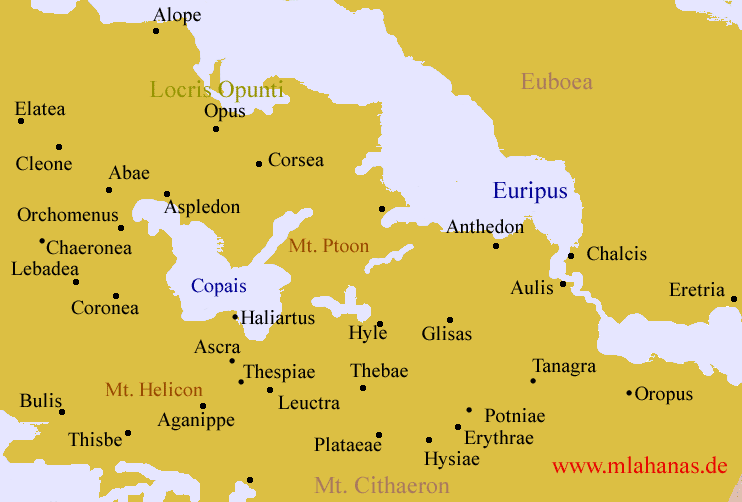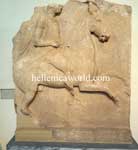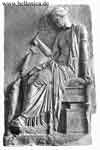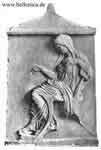.

Thespiae (Greek Θεσπιαι, Thespiai) was an ancient Greek city in Boeotia. It stood on level ground commanded by the low range of hills which runs eastward from the foot of Mount Helicon to Thebes. According to Pausanias, the deity most worshipped at Thespiae was Eros, whose primitive image was an unwrought stone. The city contained many works of art, among them the Eros of Praxiteles, one of the most famous statues in the ancient world; it drew crowds of people to Thespiae. It was carried off to Rome by Caligula, restored by Claudius, and again carried off by Nero.

Jean-Léon Gerôme, Phryne before the Areopagus. A famous person from Thespiae was the Hetaera Phryne (390-330 BC). Some Athenians considered it as a scandal that Phryne was used by Praxiteles as a model for the Cnidian Aphrodite. In 340 they tried to punish her but Hypereides was able to save her using his rhetoric power (or more likely by presenting Phryne nude).
There was also a bronze statue of Eros by Lysippos. The Thespians also worshipped the Muses, and celebrated a festival in their honor in the sacred grove on Mount Helicon. Remains of what was probably the ancient citadel are still to be seen, consisting of an oblong or oval line of fortification, solidly and regularly built. The adjacent ground to the east and south is covered with foundations, bearing witness to the extent of the ancient city. In 1882, the remains of a tomb, including a colossal stone lion, were discovered on the road to Leuctra. The tomb dates from the fifth century BC, and is probably that of the Thespians who fell at the Battle of Plataea, for those who fell at the Battle of Thermopylae were buried in the field.

742 : Grave Stele. Beotian marble. Found in Thespiai, Boeotia

828 : Grave stele. Rider, Boeotian marble. Found in Thespiai, Boeotia

Historically, Thespiae figures chiefly as an enemy of Thebes. During the Persian invasion of 480 BC it was one of the few cities in Boetia to reject the treacherous example set by the Thebans, sending seven hundred men with Leonidas to Thermopylae. After the city was burned down by Xerxes I, the remaining inhabitants furnished a force of 1800 men to the confederate Greek army at Plataea. During the Athenian invasion of Boetia in 424, the Thespian contingent of the Boetian army sustained heavy losses at the battle of Delium, and in the next year the Thebans took advantage of this temporary enfeeblement to accuse their neighbors of friendship towards Athens and to dismantle their walls. In 414 they interfered again to suppress a democratic rising. In the Corinthian war Thespiae sided with Sparta, and between 379 and 372 repeatedly served the Spartans as a base against Thebes. In the latter year they were reduced by the Thebans and compelled to send a contingent to the Battle of Leuctra in 371. It was probably shortly after this battle that the Thebans used their new predominance to destroy Thespiae and drive its people into exile. The town was rebuilt at some later time. In 171, true to its policy of opposing Thebes, it sought the friendship of Rome. It is subsequently mentioned by Strabo as a place of some size, and by Pliny as a free city.
This article incorporates text from the public domain 1911 Encyclopædia Britannica.
Greece :
A - B - C - D - E - F - G - H - I - J - K - L - M -
N - O - P - Q - R - S - T - U - V - W - X - Y - Z
| Ancient Greece
Science, Technology , Medicine , Warfare, , Biographies , Life , Cities/Places/Maps , Arts , Literature , Philosophy ,Olympics, Mythology , History , Images Medieval Greece / Byzantine Empire Science, Technology, Arts, , Warfare , Literature, Biographies, Icons, History Modern Greece Cities, Islands, Regions, Fauna/Flora ,Biographies , History , Warfare, Science/Technology, Literature, Music , Arts , Film/Actors , Sport , Fashion --- |
Retrieved from "http://en.wikipedia.org/"
All text is available under the terms of the GNU Free Documentation License



